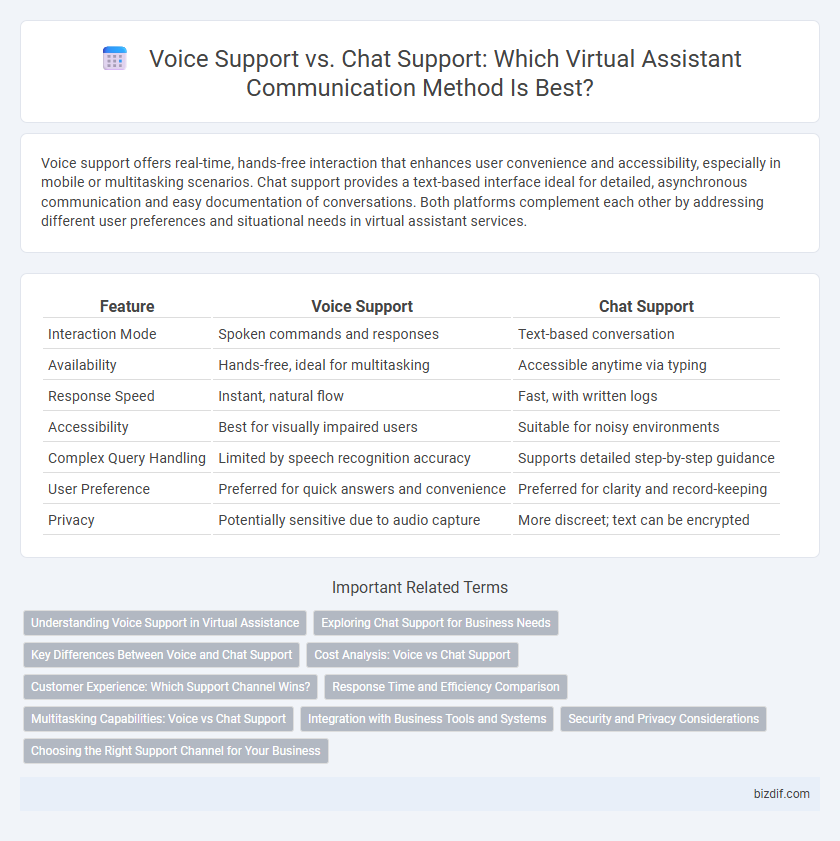Voice support offers real-time, hands-free interaction that enhances user convenience and accessibility, especially in mobile or multitasking scenarios. Chat support provides a text-based interface ideal for detailed, asynchronous communication and easy documentation of conversations. Both platforms complement each other by addressing different user preferences and situational needs in virtual assistant services.
Table of Comparison
| Feature | Voice Support | Chat Support |
|---|---|---|
| Interaction Mode | Spoken commands and responses | Text-based conversation |
| Availability | Hands-free, ideal for multitasking | Accessible anytime via typing |
| Response Speed | Instant, natural flow | Fast, with written logs |
| Accessibility | Best for visually impaired users | Suitable for noisy environments |
| Complex Query Handling | Limited by speech recognition accuracy | Supports detailed step-by-step guidance |
| User Preference | Preferred for quick answers and convenience | Preferred for clarity and record-keeping |
| Privacy | Potentially sensitive due to audio capture | More discreet; text can be encrypted |
Understanding Voice Support in Virtual Assistance
Voice support in virtual assistance leverages advanced speech recognition technology to interpret and respond to user commands, providing a natural and hands-free interaction. This mode enhances accessibility and efficiency, particularly in environments where typing or screen interaction is impractical. Integration of AI-powered natural language processing (NLP) enables virtual assistants to understand context, tone, and intent, resulting in more accurate and personalized user experiences compared to traditional chat support.
Exploring Chat Support for Business Needs
Chat support enables businesses to provide instant, text-based assistance that enhances customer engagement and boosts satisfaction rates by addressing inquiries efficiently. It supports multitasking and integrates seamlessly with CRM systems, allowing personalized interactions based on customer data and history. Compared to voice support, chat offers asynchronous communication, reducing wait times and enabling scalability to handle high volumes of queries effectively.
Key Differences Between Voice and Chat Support
Voice support offers immediate, real-time interaction allowing for nuanced tone recognition and quicker issue resolution, whereas chat support provides asynchronous communication that enables multitasking and easy record-keeping. Voice support excels in handling complex queries requiring detailed explanations, while chat support is ideal for straightforward requests and scalable customer service. The choice between voice and chat support depends on factors such as customer preference, complexity of issues, and resource availability.
Cost Analysis: Voice vs Chat Support
Voice support typically incurs higher costs due to the need for specialized telephony infrastructure, real-time audio processing, and longer handling times, whereas chat support benefits from lower operational expenses with text-based interactions and easier automation via AI chatbots. Chat support platforms enable agents to manage multiple conversations simultaneously, significantly improving agent utilization rates and reducing per-interaction costs compared to voice support. Investment in advanced natural language processing for chatbots further drives down expenses by minimizing human intervention, making chat support a more cost-effective solution for scalable customer service.
Customer Experience: Which Support Channel Wins?
Voice support offers real-time, empathetic interactions that enhance customer satisfaction by addressing emotions and nuances in tone, while chat support provides convenience and speed through asynchronous communication and easy access to transcripts. Customers often prefer voice for complex issues requiring detailed explanations, but chat support excels in handling simple queries quickly with automated responses and AI integration. The optimal customer experience depends on the complexity of the issue and the customer's preference for immediacy versus multitasking flexibility.
Response Time and Efficiency Comparison
Voice support offers instantaneous, real-time interaction, significantly reducing response time compared to chat support, which often involves typing delays and message lag. Efficiency in voice support is enhanced through natural language processing, allowing for quick issue resolution and seamless multitasking, whereas chat support relies on text accuracy and user typing speed, potentially slowing down communication. Businesses leveraging voice assistants can achieve faster customer engagement and higher satisfaction rates due to streamlined, efficient dialogue handling.
Multitasking Capabilities: Voice vs Chat Support
Voice support enables users to interact hands-free, allowing seamless multitasking during phone calls or voice commands, which is ideal for on-the-go scenarios. Chat support, while text-based, offers the advantage of asynchronous communication, enabling users to switch between tasks and respond at their convenience without immediate attention. Both voice and chat support enhance productivity, but voice excels in real-time multitasking, whereas chat support benefits those managing multiple dialogues concurrently.
Integration with Business Tools and Systems
Voice support integrates seamlessly with customer relationship management (CRM) systems and call center software, enabling real-time data access and efficient call routing that enhance customer experience. Chat support platforms often offer robust integration with helpdesk tools, ticketing systems, and automated workflows, facilitating quicker issue resolution and detailed interaction tracking. Both voice and chat support leverage APIs to connect with business analytics and marketing platforms, driving personalized customer engagements and operational insights.
Security and Privacy Considerations
Voice support in virtual assistants requires advanced encryption protocols and voice recognition technology to safeguard sensitive user data from unauthorized access, minimizing risks of voice spoofing and eavesdropping. Chat support leverages end-to-end encryption and secure messaging frameworks, ensuring that textual communications remain confidential and protected against interception or data breaches. Both modalities must comply with stringent regulations such as GDPR and HIPAA to maintain user privacy and data integrity in digital interactions.
Choosing the Right Support Channel for Your Business
Voice support offers immediate, personalized interaction ideal for resolving complex customer issues quickly, enhancing satisfaction and loyalty. Chat support provides multitasking efficiency and easy integration with AI tools, making it suitable for handling high volumes of routine inquiries cost-effectively. Evaluating your business needs, customer preferences, and support complexity ensures selecting the optimal channel to boost service quality and operational efficiency.
Voice support vs Chat support Infographic

 bizdif.com
bizdif.com